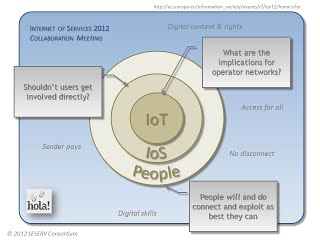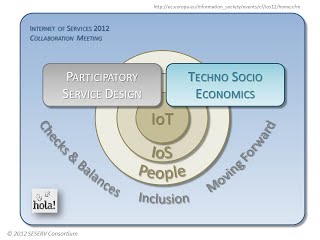posted 5 Nov 2012, 06:07 by Brian Pickering
In amongst the many sessions
at the recent Internet of Services Collaboration Meeting,
there were a couple of side sessions on participation and the socio-economics
of the Future Internet of particular interest in view of the outcomes from the
various SESERV workshops: Participatory
Service Design chaired by Kevin Doolin and Techno Socio Economics by Francesco Bellini, with contributions
from i2Web, SEQUOIA, SESERV, SocIoS and SOCIETIES, as well as the new MARKOS project. - The SOCIETIES presentation looked at ways of including end-users in service development, getting their input directly to the developers; whilst
- i2Web were mapping out the needs and common practices of disadvantaged user groups;
- the new MARKOS project is about taking open-source type collaboration to online communities;
- The SocIoS presentation looked at the economic principle and social dynamics of managing content from a quasi commercial basis;
- Two SEQUOIA presentations looked at the methodology of assessing socio-economic impact and then moved onto current results from applying this approach; whilst
- our SESERV IoS Presentation reviewed evidence that end-users are already active and willing participants despite the various challenges, and suggesting the Digital Agenda for Europe (DAE) needs to start looking elsewhere to keep the impetus going for Future Internet (FI) development.
At the end of the day, the presentations during the sessions threw up three common themes, with particular relevance to the DAE (cf for instance we reviewed the current status of the DAE as detailed here) - Inclusion: The DAE is particularly concerned with access for all, taking fast and ultra-fast connectivity to target levels of penetration (DAE Pillar 4, with attendant focus on interoperability in Pillar 2). Bogliolo had already expressed in a blanket push for certain levels of coverage in Brussels, pointing out that reaching a given level did not necessarily mean that access would be available to everyone after all (Alessandro Bogliolo's presentation can be viewed here). But more significantly at the IoS collaboration meeting, it was pointed out that: even disadvantaged users will go to great lengths to exploit what access they have (i2Web); and collaborative environments (SocIoS, and the specialised developer environment of MARKOS) are looking for new ways to engage end-users. Notwithstanding EC efforts to ensure access (for instance, the rather disturbing No Disconnect Strategy) and earlier comments on the Arab Spring and the London Riots (in SESERV Deliverable D3.1 and SESERV Deliverable D3.2), we come back to the conclusions that however difficult end-users will participate, using their own rules, and their input is not only what they want (a summary of cross-thematic issues from the SESERV Oxford workshop here) but useful.
- Checks and balances: In a presentation by Dorit Geifman from SocIoS, the focus was on the economics of Intellectual Property-type content, what it is, and how it might be handled, a topic referred to as part of DAE Pillar 1. This becomes particularly relevant in light of an implicit suggestion that such content comprises "cultural" output only. But we already know that a significant amount of content that is transmitted across the Internet is leisure-based (for instance gaming-related) and such content is causing significant concern for the carrier networks at the very least. The DAE itself is based on a premise that user consumption will drive a virtuous (economic) cycle in support of European economic growth, with Pillar 1 emphasising the digital market place and Pillar 2 the need for interoperability. What is missing though is the realisation that end-users are now prosumers or co-creators of web content, which cannot simply be ignored on the basis of low cultural appeal measured in traditional terms (cf SESERV Deliverable D3.2).
At the same time, though, there is an increasing and encouraging desire to look at the socio-economics of technology and technology projects. The SEQUOIA project has developed guidelines to assess the socio-economic impact of current or planned work. These include concrete issues for sustainability in terms of project contribution rather than the straight-forward environmental issues highlighted in DAE Pillar 7. As was presented at the workshop, the approach is relevant to a number of projects and is already showing results.
- Moving forward: The theme of the Collaboration Meeting was very much where next for the IoS. In these particular side sessions, the emphasis was very much on capturing and understanding what end-users need and how they behave. It's all about taking on board the efforts to which they will go and their experiences when using what they can (i2Web), about capitalising on their input (whether it's seen in terms of content - SocIoS - or actual software development - MARKOS), and most of all making it easy to express and realise user dreams (SOCIETIES). The DAE laid the foundation perhaps which allowed technologists to come this far; but it now needs revising (SESERV) to accommodate actual end-user engagement, and the knock-on effects for service providers and operators.

These two sessions were valuable for the different aspects of service and user engagement they presented, in the main looking forward to where project outcomes were or could be heading. From a SESERV perspective, the findings of the project's focus group discussions and workshops have much to say in this environment. In her SOCIETIES presentation, Jacqueline Floch presented a useful summary diagram: the Internet world today and perhaps in the future (see Stephen Minton's comments about pervasive devices and the IoT) is based on the Internet of Things: as we have found, we cannot underestimate the effects this will have on quality of service as well as quality of experience for content and services delivered across backbone infrastructures; on that basis (ie the IoT), different services are being developed, these have to engage and involve all stakeholders, not least the end-users; these end-users are people, and despite concerns around trust and confidence in the web security (cf DAE Pillar 3 and Alan Hartman's description of how users develop and technologies should maintain trust), they will and do do what they see fit, exploiting their experiences in a social-network context beyond the "fifteen minutes of fame" originally envisaged to shape the Future Internet as a collaborative environment for future participation and social and political engagement. |
|


